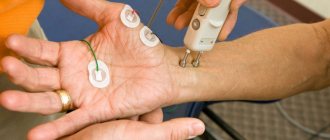General information about neurasthenia
The term “neurasthenia” is derived from two Latin roots and is translated as “weakness of the nerves.” The disease is often found in developed countries with an intense and stressful pace of life. It affects people aged 20 to 50 years. On average, every tenth adult notices certain symptoms of neurasthenia, and in women they are somewhat less common than in men.
The manifestations of the disease, at first glance, seem harmless; many are sure that the person cannot pull himself together and concentrate. In fact, the roots of the problem lie much deeper, and without the help of a doctor or at least a psychologist, it can be difficult to cope with it. Long-term neurasthenia significantly worsens the quality of life, depriving a person of the opportunity to enjoy anything, work effectively and feel confident and calm.
Make an appointment
How to deal with emotional burnout?
You can combat emotional burnout on your own by switching your attention, for example, adding walks or five-minute breaks to your workday. If emotional exhaustion occurs due to a high degree of personal responsibility, then you should learn to set priorities correctly, do important and urgent things first, and also stop yourself when trying to do something instead of others.
Since emotional burnout is always stress, it is necessary to reduce its level through physical activity, normalization of the rest regime, and a balanced diet. Actively use creativity as a way to express emotions. When it seems that strength is needed only to focus on important tasks, a person deprives himself of a resource. And then exhaustion occurs. Therefore, it is necessary to add restorative activities that bring joy and resource to your daily routine, and do this every day.
It is important to understand that emotional burnout is a whole complex of personal characteristics and external events, so it is not always possible to overcome it on your own. If a person is not able to cope with it on his own, it is necessary to seek help from a specialist - a psychologist or psychotherapist.
Reasons for development
The causes of neurasthenia are a variety of mental, somatic (related to the state of the body) and exogenous (external) factors. Most often the following problems act as a provoking factor:
- acute mental trauma or experience (death of relatives, divorce, etc.);
- exhaustion of the nervous system due to chronic multi-day stress (caring for a child or a seriously ill person, constant conflicts in the family, etc.);
- severe and/or long-term illness (oncology, infections, etc.);
- previous traumatic brain injuries, birth injuries, intracranial hypertension (act as predisposing factors);
- brain tumors, neuroinfections;
- alcohol and drug abuse;
- harmful working conditions (working with toxic substances, as well as regular mental or physical stress, overwork).
Any problem that knocks a person out of the usual rhythm of life can provoke the development of neurasthenia. If such situations are repeated regularly, the ability of the nervous system to adapt to changed conditions decreases, which provokes the development of pathology.
How to find out CMEA
As can be seen from the symptoms described, EBS or emotional burnout syndrome is easily confused with other psychosomatic disorders. Four main distinctive features will help you avoid this:
- The “patient” is so exhausted morally that he does not feel pleasure from anything. He is in constant stress and experiences only negative emotions. As a result, work and relationships with others suffer.
- The desire to develop in the profession disappears. It seems to a person that no one appreciates his work, so he can work at half capacity. Burnout can happen in other areas of life as well. For example, many people don’t see the point in taking care of themselves. “It won’t get better anyway,” they say.
- Psycho-emotional exhaustion will not disappear even after proper rest. Returning to work, the person will be just as unhappy, tired and joyless.
- Psychological burnout is based on anger, irritability and malice. This is its main difference from depression. It seems to a person that he is doing everything well, but for some reason those around him are opposed.
At first, this condition does not cause alarm. However, over time, it increasingly changes not only a person, but also his attitude towards life. He may lose his job because he cannot cope with his responsibilities. Also, such people are often turned away by loved ones who can no longer tolerate constant negativity.
Forms and symptoms
In the process of its development, neurasthenia goes through several phases, each of which has its own signs and distinctive features. In some cases, one of the phases exists in isolation, which makes it possible to distinguish it into a separate form of the disease. In the future, she can move on to the next or previous stage, or even pass completely.
Regardless of the phase, the patient may encounter problems characteristic of neurasthenia:
- increased heart rate;
- feeling of strong heartbeat;
- pressing or stabbing pain in the chest;
- increased blood pressure;
- paleness of the face or, conversely, redness;
- digestive problems: heartburn, belching, bloating, constipation or diarrhea;
- frequent urge to urinate under stress;
- decreased libido, sexual disorders (premature ejaculation, impotence, anorgasmia).
Each of these symptoms can appear alone or in combination with others.
Hypersthenic form (phase)
This form is manifested by excessive irritability and emotional instability. Any little thing can make a person angry: loud noise, extraneous conversation, a large crowd of people or a seeming lack of attention from others. As a result, the patient begins to scream, curse, or insult at the slightest provocation.
Performance in this phase suffers significantly due to severe inattention. The person does not feel tired, but it is very difficult for him to concentrate on the process. He collects his thoughts for a long time, and then is constantly distracted by some extraneous irritant. The vicious circle is repeated dozens and even hundreds of times during the day, which significantly affects the result, making the person even more nervous.
Characteristic symptoms of the hypersthenic phase are:
- sleep disorders: prolonged falling asleep, frequent awakenings during the night, nightmares;
- feeling tired and tired in the morning;
- drowsiness during the day;
- pressing headache like a helmet or a subjective feeling of heaviness in the head;
- decreased attention and memory;
- discomfort inside the body (in the area of the heart, stomach, intestines, etc.).
Irritable weakness
This is the second phase of neurasthenia, which develops if the provoking factors have not been eliminated. Outbursts of anger, rage and irritation continue to arise at the slightest provocation, but they quickly fade away, leaving behind complete mental exhaustion. Often the attack ends in apathy and tears.
The patient's ability to work continues to deteriorate. He hardly forces himself to start doing anything, but almost immediately stops due to severe fatigue and headache. Attempts to finish the task can be repeated several times throughout the day and, ultimately, exhaust the person. He feels immense weakness, fatigue and weakness to the point of complete exhaustion.
The phase of irritable weakness can develop independently. People with an explosive, emotional temperament (cholerics) or initially strong, self-confident and balanced people (phlegmatics) are most susceptible to it.
Hyposthenic form (phase)
With a consistent course of neurasthenia, this phase is the final one, but anxious and suspicious people can encounter it already in the early stages of the development of the disease. Hyposthenia is characterized by:
- constant physical and mental weakness;
- apathy;
- anhedonia (loss of the ability to enjoy life);
- emotional instability, tearfulness;
- lack of interests and hobbies;
- severe hypochondria.
In fact, a person becomes fixated on himself and his asthenic state, constantly looking for signs of various diseases. During this phase, the general symptoms described above often occur, which reinforce the patient's belief in poor health.
If the factor that caused the exacerbation of neurasthenia is eliminated, or the patient is prescribed effective therapy, the disease begins to recover, no matter what phase of development it is at. Repeated attacks are characterized by greater severity of symptoms, as well as an increase in the duration of recovery.
Symptoms of asthenia (main)
- a feeling of fatigue, powerlessness, malaise, in which rest does not bring relief;
- inattention, inability to concentrate, poor assimilation of new material, getting stuck on small, unimportant details when talking or reading;
- increased distractibility, the thread of conversation or thought is easily lost;
- irritability, unstable mood, easy tearfulness;
- increased sensitivity to sounds, smells, light, touch, taste;
- disturbed sleep, difficulty falling asleep, early awakenings, daytime sleepiness, lack of sleep after waking up;
- headaches and dizziness;
- increased anxiety;
- worsening of the condition when the weather changes or when staying in a hot room;
- autonomic disorders: palpitations, pressure fluctuations, sweating, feeling of shortness of breath, discomfort in different parts of the body.
Diagnostics
Neurologists, psychiatrists and psychotherapists can diagnose neurasthenia. To make a diagnosis they use the following methods:
- collection of complaints and medical history: the doctor finds out what exactly is bothering the patient, how long ago and against what background it started, under what circumstances it gets better or worse; special attention is paid to past illnesses or injuries, family and work environment, heredity, etc.;
- psychological assessment: during a conversation with a patient, the doctor pays attention to the emotional coloring and volume of speech, gestures, etc.; after the conversation, the person is asked to perform several tests that will help determine the level of anxiety, depression, asthenia, etc.
- general examination: blood and urine tests, ECG, hormone tests and other examinations are necessary if there are relevant complaints; So, for pain in the heart area, a cardiological examination will be required, and for digestive problems, a consultation with a gastroenterologist;
- exclusion of organic pathology of the nervous system: a thorough neurological examination, MRI or CT scan of the brain, ultrasound examination of the arteries of the head and neck and other examinations are performed to identify the possible cause of the patient’s painful condition.
It is important not only to diagnose neurasthenia, but also to distinguish it from a more severe and formidable pathology - depression. There are a number of fundamental differences between them:
- reason: neurasthenia always occurs as a reaction of the body to acute or chronic stress, overwork, etc.; depression often develops for no apparent reason;
- condition during the day: with neurasthenia, patients feel better in the morning, symptoms increase as fatigue increases; with depression in the evening, on the contrary, it becomes better;
- seasonal dependence: depression worsens in spring or autumn, while neurasthenia can occur with equal probability at any time of the year;
- response to treatment: when the cause is eliminated and treatment is prescribed, neurasthenia disappears completely, while depression often worsens again.
Consequences of exhaustion
Asthenic neurosis
Asthenic neurosis occurs when there is an internal conflict between “should” and “can”.
At the same time, you demand more from yourself than your body can handle - work more, sleep less. As a result, the body refuses to obey, you cannot even carry out your usual tasks. This ends either with a visit to a psychiatrist or with a somatic illness.
Somatic diseases and symptoms
You may experience chronic pain (spinal pain, headache), as well as complications of viral diseases (bronchitis, pneumonia).
By overloading yourself, you can become seriously ill. Illnesses caused by distress include:
- Heart attacks;
- Strokes;
- Hypertension;
- Tachycardia;
- Gastritis and stomach ulcers;
- Disorders of the thyroid gland;
- Bronchial asthma.
Psychotic conditions
Due to lack of sleep and rest, symptoms of psychosis may occur. Hallucinations often occur with sleep deprivation.
Treatment of neurasthenia
Treatment will be successful only if the factor that provoked the disease is eliminated. The patient is recommended:
- follow a daily routine, go to bed on time;
- get proper rest, avoid overwork and overexertion;
- change the environment if possible;
- eat right, avoid undereating or overeating;
- eliminate the use of alcohol, drugs, smoking;
- regularly walk in the fresh air, play sports at an amateur level.
A good effect is achieved using various types of psychotherapy. Sessions with a doctor help identify blocked traumas and experiences, cope with acute or chronic stress, and restore the depleted resource of the nervous system. In addition to working during the appointment, the specialist teaches the patient auto-training techniques that help stabilize the psyche.
Medications are prescribed depending on the phase of the disease:
- the hypersthenic phase requires the prescription of tranquilizers and sleeping pills, which help reduce the excitability of the nervous system and improve sleep;
- the hyposthenic form is a reason to prescribe tonics: caffeine, eleutherococcus, ginseng, etc.
Certain symptoms of neurasthenia can be corrected with the help of nootropics, angioprotectors, and B vitamins that improve the functioning of the central nervous system.
Non-drug methods of influence help increase the effectiveness of treatment:
- physiotherapy: electrosleep, various applications;
- restorative massage;
- acupuncture;
- various relaxing procedures (floating, aromatherapy, etc.).
Make an appointment
Preventing emotional burnout
In order to prevent the development of emotional burnout, it is necessary to create such an atmosphere in your own life so that positive emotions and a variety of activities are constantly present.
The most effective methods to help prevent burnout if you are already experiencing some of its symptoms:
- Changes. You can change your job, change your route home, sign up for additional courses, move furniture or update your wardrobe. Any changes stimulate interest in life and activate the psyche. This helps to break out of the monotony of the same activities.
- Privacy. Walk alone or sit in silence for half an hour, locking the door, which will help you quickly restore strength in the middle of the day.
- Self-expression. Through creative expression of emotions, such as dancing, drawing, singing, a person is freed from negative experiences. In addition, any creativity helps to realize the potential for which there is no outlet in a space where burnout occurs.
- Physical activity. Any physical exercise relieves stress, be it the gym, running, yoga or physical labor (chopping wood, mowing grass, hanging wallpaper, etc.).
You need to learn to plan your day so that there is time not only for urgent matters, but also for relaxation and for your favorite activities. If you set aside a whole weekend for relaxation, but spend it scrolling through your social feed, then the resource is not replenished. It is important to be able to completely disconnect from work or caring for your ward for this period of time and immerse yourself in what makes you happy, and not be in standby mode. It is very important to receive strong positive emotions.
Treatment at the Energy of Health clinic
If stress and fatigue are the cause of loss of strength, the doctors at the Health Energy clinic will come to the rescue. First, we conduct a detailed examination that will help exclude other causes of pathological symptoms, and prescribe consultations with specialized specialists and tests necessary to assess the situation. Then you will be offered comprehensive treatment, which includes:
- individual selection of medications in accordance with the symptoms and characteristics of the body;
- modern psychotherapeutic techniques;
- physiotherapy, massage, physical therapy to stabilize the condition;
- organization of sanatorium-resort treatment.
Professional burnout
Professional burnout is one of the variants of professional deformation. Most often it manifests itself in people in helping professions or in those who are forced to have a lot of contact with people (colleagues, customers, patients, customers, etc.). Also at risk of professional burnout are closed individuals who accumulate all emotions within themselves, those who are afraid of losing their job and therefore feel a constant need to prove their competence. Internal conflict regarding work demands, such as level of responsibility, salary, number of days off, or the ability to take vacations, can also lead to burnout.
Burnout leads to loss of strength, decreased performance, productivity, failure to complete assigned tasks and the development of psychosomatic disorders.
Our advantages
The multidisciplinary medical center offers each visitor services for the diagnosis and treatment of various diseases. Our advantages include:
- the most popular areas of work: neurology, cardiology, surgery, gastroenterology, etc.;
- modern diagnostic equipment;
- all types of laboratory analyzes and tests;
- the most effective methods of treating various pathologies;
- individual approach to the selection of therapy;
- auxiliary treatment methods: physiotherapy, physical therapy, massage;
- comfortable day rooms;
- Appointment by appointment at a time convenient for the patient;
- affordable prices for all services.
Neurasthenia is a disease in which a person does not have the strength to pull himself together. Without qualified help and elimination of the traumatic factor, it will progress, increasingly depleting the nervous system. Help yourself get out of the vicious circle, sign up with Health Energy specialists.








